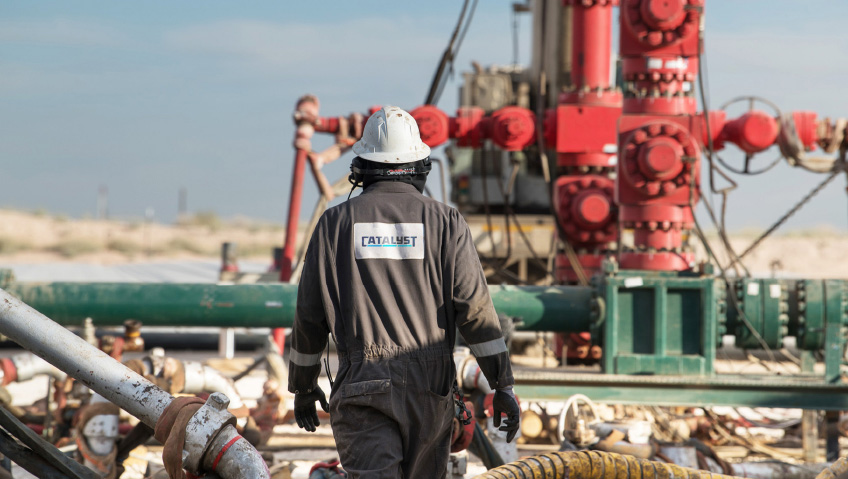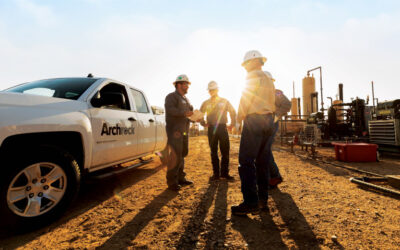When Catalyst Energy Services was profiled in the September 2022 issue of Resource in Focus, the Texas-based company had just released its highly innovative Vortex Prime pumping system. Vortex Prime is designed to reduce costs, emissions, and maintenance during hydraulic fracturing operations to recover natural gas. Now, Catalyst has a case study with data that aptly demonstrates the merits of its cutting-edge pump solution.
“The beauty of the case study for us was that it allowed us to prove on a scale what we had been calculating and saying for quite a while—that this technology is perfectly suited for small locations where size or layout might be a challenge,” states Seth Moore, Chief Operating Officer and Catalyst co-founder.
Hydraulic fracturing is a drilling technique in which water, sand, or chemicals are blasted into a wellbore under high pressure to break up rock formations so natural gas and oil can be extracted. Vortex Prime offers an alternative to conventional fracking fleets—the energy industry term for the rigs, trucks, vehicles, pumps, and other equipment needed for hydraulic fracturing. The Vortex Prime fracking fleet is the first of its type to use direct-drive turbine technology.
The pumps are directly connected to military-grade turbines fueled by natural gas. The self-contained system is compact, requiring six to eight pumps versus twenty for a conventional fleet, reducing onsite space by over 50 percent. It also offers big power, speedy set-up, fuel savings, and reduced emissions and maintenance.
“We have said all along, ‘Look at the fuel savings that this technology can achieve.’ We were able to prove that,” he says, pointing to Catalyst’s case study. “When all things were considered, we saved the customer substantial money.”
Released March 4, 2023, the case study concerns an assignment that the company carried out at a small, two-well pad in Howard County, Texas. At the customer’s request, a hybrid solution was implemented, with 75 percent of pumping done with Vortex Prime and the remainder done with conventional diesel-powered pumps.
The Vortex Prime system pumped for 261 hours over 17.2 days, with an average treating pressure of 8,110 psi and a maximum treating pressure of 8,465 psi. The system can reach nearly 15,000 psi depending on how it is configured. 92 percent pumping efficiency was achieved, carbon dioxide emissions were reduced by 654 metric tons, and the client’s fuel costs were slashed by 41 percent, for a savings of $425,000.
“That fuel savings number could have been even higher than what it was if we had run all the turbines,” notes Moore.
In addition to taking up less space than a conventional fleet, the Vortex Prime system used in the case study required less maintenance, enhancing the safety of the fracking crew. Fewer pieces to transport meant less need for back-and-forth trips to the worksite. It offers other benefits as well, including a kill switch feature that cuts idle time. The system can be put back online in minutes, versus hours for a traditional fracking fleet. The company makes the Vortex Prime at its manufacturing facilities and also offers conventional fracking pump options.
There have been other big developments recently at Catalyst besides the case study. At the start of this year, the company announced a partnership with GD Energy Products (GDEP), a company that has been designing and manufacturing pump solutions for the oil and gas industry since the mid-19th century. Under the terms of the agreement, Catalyst will be using GDEP’s Thunder 5000 quintuplex pump, capable of reaching 5,000 horsepower, in the Vortex Prime system.
“It’s a spinoff of their GD 3000 pump, which was a triplex pump—a three-plunger pump. This was a five-plunger pump. We went to them and gave them a challenge, and they partnered with us,” he says. “Both companies are working in a collaborative partnership.”
Catalyst was established in April 2018 by Moore and two co-founders, all of whom were imbued with a predilection for out-of-the-box thinking. Sadly, after we last spoke, company co-founder Michael Morgan passed away. Moore and fellow co-founder Bobby Chapman are determined to respect Morgan’s vision as they keep the company going.
“It was a sad passing, hard to comprehend. Our thoughts are with his family and friends. The employees who worked with him are touched by his loss. Bobby, Mike, and myself were here before the beginning of Catalyst, and our success is certainly due in part to his efforts and his knowledge and skill and experience,” Moore says, adding, “He would want us to go on.”
Part of this going forward involves remaining true to the company’s original mission, which was to be innovative and open-minded about new technology and processes. Indeed, for all of its success, remaining flexible and agile is the goal.
“I don’t consider us a start-up anymore, but we still have a lot of that start-up mentality. We go from concept to action pretty quickly. There are not a lot of layers for ideas to get bogged down in and shrivel on the vine,” he explains.
As proof, he points to the speed at which Catalyst can erect and dismantle its fracking operations. “We can move our pumps, set up, and be ready in twelve hours or less. My guys are telling me I can get it down to eight hours; I don’t know any system in the fracking world that does that,” Moore says.
Quick installation, of course, means more pumping time for clients. This dynamic approach also draws potential employees who want to break away from the more conservative mindset inherent in the conventional oil and gas sector.
“If people have ways of doing things better, faster, safer, more efficient, and profitable, we listen to those people. Sometimes, our meeting in the morning can result in action being taken after lunch. I think that appeals to a lot of people, and because of that, we’ve been able to get some really good talent,” states Moore. Current employment at Catalyst stands at approximately 185 individuals.
The company’s business model is centered on rentals. Instead of selling the Vortex Prime and other fracking solutions, Catalyst leases out equipment and crews. The firm remains focused on the Permian Basin—a region encompassing West Texas and Southeast New Mexico containing vast oil and natural gas deposits.
“There’s a lot of work in the Permian,” says Moore, “and we’ve had people reach out to us from outside the United States and areas outside the Permian Basin. Currently, we’re building capacity,” he explains. “At the moment, it seems to make the most sense to keep this technology operating as close to our home base as possible. We like the fact that we don’t have to fly in experts. We’ve partnered with people who have boots on the ground.”
Like other fracking companies in the Permian Basin, Catalyst has had to respond to certain industry trends, including simultaneous fracturing, aka simul-frac, and electric fracturing, or e-frac. Moore is a strong proponent of the former and not a huge fan of the latter.
While conventional fracking fleets use diesel-powered pumps, e-frac systems run on electricity. By using an e-frac fleet, energy companies can reduce fuel consumption and greenhouse gas emissions, but it is hardly a perfect solution. Large-scale e-frac systems have such high energy needs that they cannot be plugged into an existing electrical grid, and this would not be a realistic option in much of the Permian Basin anyway.
The Texas electrical grid is independent of other state grids, leaving it highly vulnerable to unexpected surges in demand. A cold snap in the Lone Star State in early 2021 resulted in the near-collapse of the grid as Texans cranked their thermostats.
“When people say e-frac, they assume it’s easy and quick and clean; they don’t realize all that goes into it,” Moore says. Gas-powered generators are needed to create electricity for e-frac systems, a requirement that can be expensive and inconvenient.
He is considerably more enthusiastic about the emergence of simul-frac, a hydraulic fracturing process entailing the use of two horizontal wells at the same time. “We feel [our] technology is perfectly suited for simul-frac because it amplifies and multiplies that fuel saving,” he shares. The compact size of the Vortex Prime system also means it is a good fit for simul-frac operations.
When asked about the future, Moore anticipates expansion. “I think we’d like to be at eight fleets by the end of 2024. We should be adding our fourth fleet somewhere in Q4 of this year, so that’s a growth of four fleets next calendar year. We’ve talked about all kinds of options but, at the end of it all, we’re focused on making sure we grow in a [controlled] manner and that we maintain service quality and maintain safety. We feel like everything good that will happen, will happen as long as we manage those things.”













